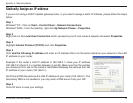
4D-Link DES-1108 User Manual
Section 1 - Product Overview
Introduction
Fast Ethernet Technology
The growing importance of LANs and the increasing complexity of desktop computing applications are fueling the need
for high performance networks. 100BASE-TX (Fast Ethernet) provides a cost-effective and high-performance solution for
small workgroups, SMBs (Small to Medium Businesses), and any network supporting bandwidth-intensive applications.
Fast Ethernet technology operates at 10 times the speed of traditional Ethernet, offering maximum performance and
enhanced capability for existing Ethernet-based networks.
100Mbps Fast Ethernet is a standard specified by the IEEE 802.3 LAN committee. It is an extension of the 10Mbps
Ethernet standard with the ability to transmit and receive data at 100Mbps, while maintaining the CSMA/CD Ethernet
protocol. Since the 100Mbps Fast Ethernet is compatible with all other 10Mbps Ethernet environments, it provides
a straightforward upgrade and takes advantage of the existing investment in hardware, software, and personnel
training.
Switching Technology
Switching is a cost-effective way of increasing the total network capacity available to users on a LAN. If an Ethernet
network begins to display symptoms of congestion, low throughput, slow response times, and high rates of collision,
installing a switch to a network can preserve much or all of the existing network’s cabling and workstation interface card
infrastructure, while still greatly enhancing the throughput for users. A switch is a viable solution even if demanding
applications, such as multimedia production and video conferencing, are on the horizon. The most promising techniques,
as well as the best return on investment, could well consist of installing the right mixture of Ethernet switches.
A switch increases capacity and decreases network loading by dividing a local area network into different LAN
segments. Dividing a LAN into multiple segments is one of the most common ways of increasing available bandwidth.
If segmented correctly, most network traffic will remain within a single segment, enjoying the full-line speed bandwidth
of that segment.


















